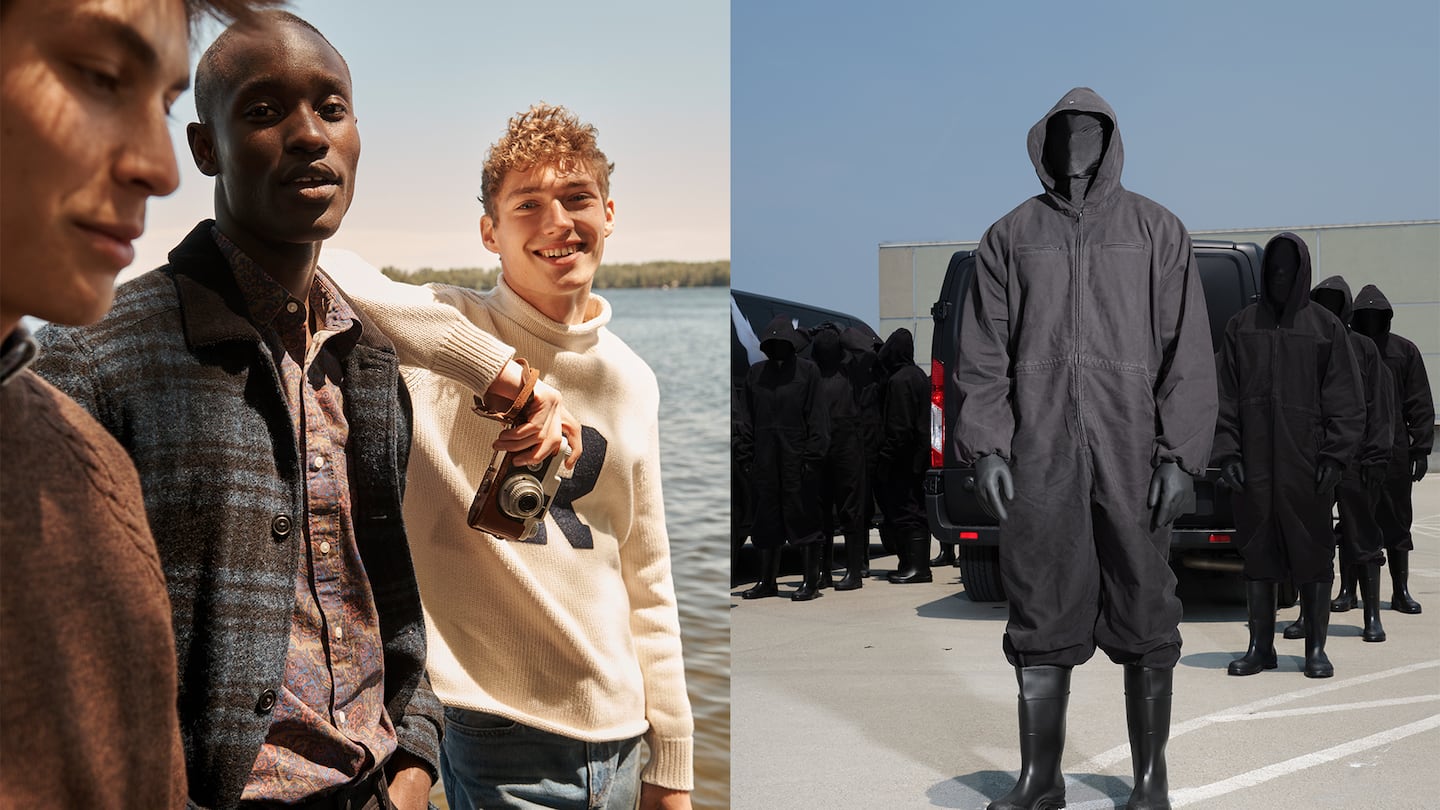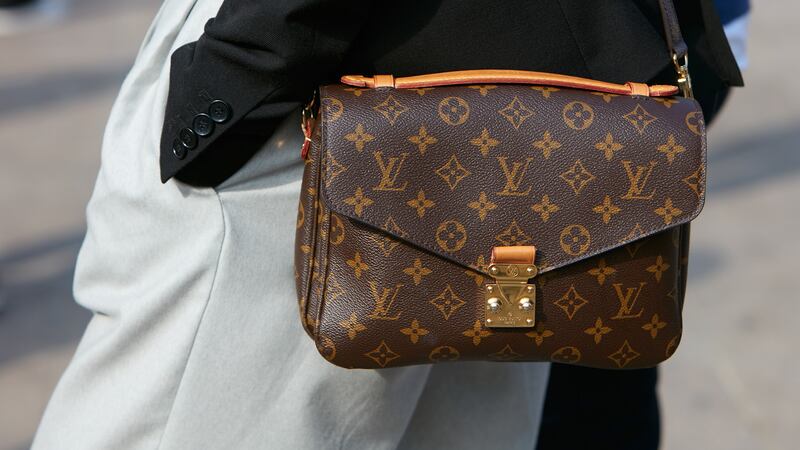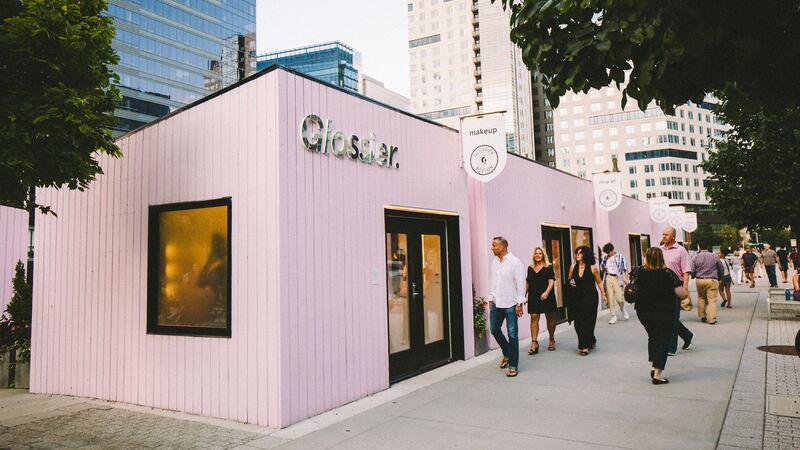
The Business of Fashion
Agenda-setting intelligence, analysis and advice for the global fashion community.

Agenda-setting intelligence, analysis and advice for the global fashion community.

J.Crew and Gap both took big steps this week to turn long-hyped but little-seen comeback efforts into clothes that people can actually buy. At J.Crew, it was the debut collection of menswear creative director Brendon Babenzien. For Gap, it was the retail rollout of its collaboration with Yeezy and Balenciaga.
The two brands have a similar backstory: each had a charmed run where they defined how millions of people dressed for much of the 1990s and 2000s. Then it all fell apart: the clothing grew stale, the malls emptied out and fast fashion took over. The pandemic was a breaking point, with J.Crew filing for bankruptcy and Gap closing hundreds of stores.
Both retailers made their bid to change the narrative. In 2020, Gap and the rapper then known as Kanye West formed a 10-year partnership, Yeezy Gap. Less than a year later, in May 2021, J.Crew announced Babenzien, a former Supreme creative director with his own label, Noah, would design menswear for the retailer.
From there, J.Crew and Gap took radically different paths. Only one appears to be going in the right direction.
ADVERTISEMENT
This was not a foregone conclusion two years ago. What went right for J.Crew, and what went wrong for Gap?
J.Crew’s big move was the less radical of the two — hiring a pair of well-regarded designers in Babenzien as well as Olympia Gayot in womenswear, and tasking each with subtly introducing trendier pieces that stuck close to the retailer’s core preppy product offering. The company was in a much deeper hole than Gap; some questioned whether it had a future post-bankruptcy, or if it would be acquired by a licensing firm like its mall neighbour Brooks Brothers.
Gayot’s influence was felt first in stores and helped drive rising sales. The better-known Babenzien received immediate — if not quite universal — praise from his debut collection that was released Monday. A pair of wide-leg trousers — a silhouette Noah is known for — is making the rounds on menswear Twitter and Instagram.
Gap, on the other hand, sunk its resources into a much flashier collection that promised to be a clean break from its main assortment. A New York Times report last week pointed to trouble behind the scenes, with Yeezy Gap originally planning a meeting of aesthetics similar to J.Crew’s bet on Babenzien, only to head in a drastically different direction. In its first 18 months, the partnership with Ye produced just two products — a puffer jacket and a cotton hoodie.
In January, Balenciaga’s Demna Gvasalia (now simply known as Demna) stepped in to create a three-way capsule — Yeezy Gap Engineered By Balenciaga, resulting in the collection released in stores this week.
For Gap, the slow rollout was the least of its problems. For a retailer of its size, the arrival of a creative force as high-profile as Ye should have been felt throughout the company. Instead, Yeezy Gap has operated as an almost independent entity within Gap Inc. No mainline Gap product available today appears to have been influenced by Ye. The Yeezy collection exists on a different website from Gap.com (meanwhile, Balenciaga hosted the collaboration on its main website).
This disparate approach is visible in the Times Square store that was first to carry Yeezy Gap. The bags full of hoodies and oversized T-shirts are housed separately from Gap merchandise, in a room with walls and even the cash registers painted black. It’s as if Yeezy were an unrelated pop-up that happened to rent out vacant space in Gap stores.
On some level, the disconnect comes off almost like an admission that no Yeezy fan was ever going to shop Gap’s main line, even if they had to visit the store to try on a hoodie.
ADVERTISEMENT
As a result, Gap has not seen much of a marketing boost from all the hype around Yeezy this week. The latter brand received more than seven times as many mentions as Gap on social media over the last 14 days, according to brand sentiment firm Brandwatch.
“Here is the problem for the Gap, they are playing third fiddle to Yeezy and Balenciaga,” said Kellan Terry, head of communications at Brandwatch.
To be sure, the products sell well. Gap said the Yeezy hoodie released last year broke single-day online sales records. But a limited line isn’t enough to bolster the whole business. In its most recent reported quarter, the retailer posted sales of $3.5 billion — down 13 percent from a year prior.
It’s clear that Gap’s board of directors aren’t happy. Earlier this month, Sonia Syngal, the retailer’s chief executive under whom the Yeezy partnership was announced, exited the company abruptly. Balenciaga’s involvement is over as well, and there’s no word on what’s next for Yeezy Gap once the current collection sells through. Barring a dramatic shift in strategy — not impossible given the personalities involved — Gap has on its hands a successful but miniscule sub-brand, and is back to square one when it comes to rescuing the company itself.
Under chief executive officer Libby Wadle at J.Crew, on the other hand, the turnaround strategy from day one was rooted in the nuts and bolts of retail. Today, the entire offering feels unified in its vision. J.Crew was able to achieve this by hiring creative leaders who could tap into the current fashion moment and had a history of collaboration, rather than banking on the vision of one iconoclastic superstar. In its first quarter of 2022, J.Crew sales grew 25 percent.
“Where Babenzien’s celebrity and influence is tied to J.Crew in this particular instance, the Gap finds itself in the completely opposite scenario to J.Crew,” said Terry. “The Gap is tied to West’s celebrity.”
J.Crew is not immune to industry headwinds. With persistent inflation and a possible recession looming on the horizon, the retailer’s run of strong sales may end. Babenzien’s work hasn’t been universally lauded; some menswear influencers have called it derivative of prep-inspired brands like Aimé Leon Dore. It remains to be seen if the general public will want to wear those giant chinos.
But J.Crew has given itself the best possible chance at success by taking a balanced approach with products that satisfy both old and new customers. Gap has managed to drive sales from hypebeasts thanks to Yeezy, but they’ll likely never be lifelong customers.
ADVERTISEMENT
THE NEWS IN BRIEF
FASHION, BUSINESS AND THE ECONOMY

LVMH sales jump despite China slowdown. Fashion and leather goods revenue rose 19 percent in the second quarter, beating analyst estimates.
Kering hurt by China presence amid lockdowns. Sales at Gucci, which has greater exposure in China than other luxury labels, rose 4 percent on a comparable basis during the second quarter, the fashion group said Wednesday. Analysts expected a 4.6 percent gain, according to a survey by Bloomberg.
Prada first-half revenue rebounds on Europe, Americas sales. First-half revenue rose 22 percent to €1.9 billion ($1.93 billion), as retail sales in Europe and the Americas grew 89 percent and 41 percent respectively. Net income totalled €188 million for the period, compared with €97 million in the first half of 2021.
Moncler beats first-half sales expectations. Despite slowdowns in China, sales rose 46 percent at the Italian luxury group, driven by growth in the US and Europe. Revenue was up 48 percent year-on-year, reaching 918.4 million euros ($929.9 million).
Adidas issues profit warning amid China lockdown woes. Sales will now rise by mid-to-high single digits on a currency-neutral basis this fiscal year, down from previous guidance they would grow by 11 percent to 13 percent, the company said in a statement Tuesday.
Walmart ‘train wreck’ profit warning sends shares down 10 percent. Walmart, a bellwether for the retail sector that caters to cost-conscious shoppers, said its full-year profit would decline 11 percent to 13 percent, compared to the 1 percent fall it previously forecast.
Shein private bids imply $30 billion valuation drop since April, sources say. Investors looking to sell stakes in Shein are evaluating bids at discounts of about 30 percent, amid concerns about the Chinese fast-fashion giant’s slowing growth, people familiar with the matter told Bloomberg.
US economy shrinks for a second quarter, raising recession odds. Gross domestic product fell at a 0.9 percent annualised rate after a 1.6 percent decline in the first three months of the year, the Commerce Department’s preliminary estimate showed Thursday.
Frasers Group acquires fast fashion retailer I Saw It First. The acquisition of I Saw It First is the latest in a series of deals by the fashion group, which also owns department store chain House of Fraser and luxury fashion retailer Flannels.
Shopify will cut 10 percent of its staff. Most of the affected roles are in recruiting, support and sales, chief executive officer Tobi Lutke said in a memo posted on the company’s website, also acknowledging the company’s decision to expand rapidly coming out of the Covid-19 pandemic didn’t pay off.
THE BUSINESS OF BEAUTY

Glossier will sell products at Sephora next year. The beauty company that defined the look and business model for countless digital brands just signed its first major wholesale deal, signalling an end to the golden age of direct-to-consumer.
L’Oréal bucks trend with Chinese sales growth in Q2. The cosmetics group said on Thursday overall sales for the three months to June came in at €9.31 billion ($9.46 billion), an increase of 13.4 percent on a like-for-like basis. The figure beat analyst expectations for an 8.9 percent rise in revenues, according to a Visible Alpha consensus cited by UBS.
PEOPLE

Balenciaga’s Demna tapped by President Zelensky to raise funds for Ukraine. The brand will release a T-shirt to raise money and awareness for United24′s Rebuild Ukraine fund.
MEDIA AND TECHNOLOGY

Alibaba seeks primary Hong Kong listing to woo Chinese money. The move further entrenches the financial hub’s status as an alternative to US markets ahead of a potential exodus of Chinese companies from New York.
Kylie Jenner reposts critique of Instagram: ‘stop trying to be TikTok.’ Instagram owner Meta has changed the app to be more like Bytedance’s TikTok, prioritising short-form videos and an algorithm that suggests content to users that they aren’t already following.
Compiled by Joan Kennedy
Antitrust enforcers said Tapestry’s acquisition of Capri would raise prices on handbags and accessories in the affordable luxury sector, harming consumers.
As a push to maximise sales of its popular Samba model starts to weigh on its desirability, the German sportswear giant is betting on other retro sneaker styles to tap surging demand for the 1980s ‘Terrace’ look. But fashion cycles come and go, cautions Andrea Felsted.
The rental platform saw its stock soar last week after predicting it would hit a key profitability metric this year. A new marketing push and more robust inventory are the key to unlocking elusive growth, CEO Jenn Hyman tells BoF.
Nordstrom, Tod’s and L’Occitane are all pushing for privatisation. Ultimately, their fate will not be determined by whether they are under the scrutiny of public investors.